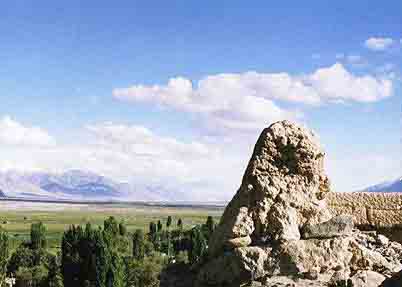| Legole.Com Discover china. Explore the beauty and wonder of the land, people, and culture of China. |
 |
|
|
 |
 46 kilometers (29 miles) southeast of Turpan near the "Flaming Mountains" sit impressive ruins of the ancient city of Gaochang. Built in the first century B.C. and originally called Gaochangbi, it used to be a garrison town and later became a key point along the ancient Silk Road. By the seventh century it held sway authority over 21 other towns and the practice of Buddhism led to the establishment of many monasteries and temples. In the ninth century, the Uigur established the Kharakhoja Kingdom here and Manicheamism flourished. The city was burnt down around the 14th century, during a period of warfare that lasted 40 years. 46 kilometers (29 miles) southeast of Turpan near the "Flaming Mountains" sit impressive ruins of the ancient city of Gaochang. Built in the first century B.C. and originally called Gaochangbi, it used to be a garrison town and later became a key point along the ancient Silk Road. By the seventh century it held sway authority over 21 other towns and the practice of Buddhism led to the establishment of many monasteries and temples. In the ninth century, the Uigur established the Kharakhoja Kingdom here and Manicheamism flourished. The city was burnt down around the 14th century, during a period of warfare that lasted 40 years.
The ruins originally consisted of three parts: the inner and outer cities, and a palace complex. The outer city extended 5.4 kilometers (3.4 miles) long with 11.5-meter-(38-foot-) high and 12-meter-(40-foot-) thick enclosure walls. Some section of the tamped earth were reinforced with adobe. Nine city gates were built at cardinal points; three in the south and two in each other three directions. Visitors are usually suggested to enter the best preserved gate in the west to the core.
The inner city is a 3-kilometer (1.86 miles) long rectangle, of which the western and eastern sections are well preserved. Sharing its southern wall with the inner city, the Palace City is in the northern part of the inner walls. A square adobe pagoda called "Khan's castle", which means "Imperial Palace", stands on a high terrace in the very north. Somewhat to its west, a half-underground, two-storied structure is supposed to be the palace ruins. Several earthen platforms are still visible.
Two temple remains, one in the southwestern and other in the northwestern parts of the outer city are worth a visit. The first one, 130 meters (427 feet) long from east to west, 85 meters (279 feet) wide from south to north covers 10,000 square meters. It consists of an arched gate, courtyard, a lecture hall, a library of sutras, a main hall and the monks' dormitory. It is said that Xuanzang the renowned Buddhist monk of the Tang period had lectures here in the year of 628 on his way to India. The second is smaller but the murals remains are impressive. The city was brought under the protection of the state in 1961.
Admission Fee: 30
Recommended Time
for a Visit: One and a half hours |
 |
|
|
 |
|
